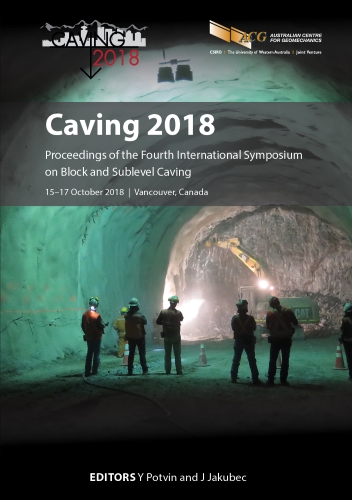Identifying a migrating stress front using apparent stress for an unplanned rock mass cave

|
Authors: Brown, LG; Hudyma, MR |
DOI https://doi.org/10.36487/ACG_rep/1815_44_Brown
Cite As:
Brown, LG & Hudyma, MR 2018, 'Identifying a migrating stress front using apparent stress for an unplanned rock mass cave', in Y Potvin & J Jakubec (eds), Caving 2018: Proceedings of the Fourth International Symposium on Block and Sublevel Caving, Australian Centre for Geomechanics, Perth, pp. 565-576, https://doi.org/10.36487/ACG_rep/1815_44_Brown
Abstract:
Throughout a mining environment, variations in geotechnical and stress conditions can lead to unplanned rock mass failure. For operations with microseismic monitoring capabilities, seismic event locations and source parameters can often provide significant insight into rock mass failure processes. This paper presents observed variations in the seismic source parameter, apparent stress, during an unplanned rock mass cave in a deep Canadian mine. Over the course of six months, the rock mass cave propagates upwards more than 75 m, at more than 1,000 m depth below surface. Emphasis is placed on identifying zones of relatively high rock mass stress as the cave propagates upwards over time.
Keywords: unplanned caving, seismicity, apparent stress, rock mass stress, underground mining
References:
Abolfazlzadeh, Y & Hudyma, M 2016, ‘Identifying and describing a seismogenic zone in a sublevel caving mine’, Rock Mechanics and Rock Engineering, vol. 49, no. pp. 3735–3751.
Brown, L & Hudyma, MR 2017, ‘Identification of stress change within a rock mass through apparent stress of local seismic events’, Rock Mechanics and Rock Engineering, vol. 50, no. 1, pp. 81–88.
Butcher, R 2003, ‘Caving geomechanics’, Proceedings of ACG Seminar 0309, Australian Centre for Geomechanics, Perth.
Domanski, B & Gibowicz, SJ 2008, ‘Comparison of source parameters estimated in the frequency and time domains for seismic events at the Rudna copper mine, Poland’, Acta Geophysica, vol. 56, no. 2, pp. 324–343.
Duplancic, P & Brady, BH 1999, ‘Characterization of caving mechanisms by analysis of seismicity and rock stress’, in G Vouille & P Berest (eds), Proceedings of the Ninth International Congress of Rock Mechanics, International Society for Rock Mechanics and Rock Engineering, Lisbon, pp. 1049–1053.
Gibowicz, SJ, Harjes, HP & Schafer, M 1990, ‘Source parameters of seismic events at Heinrich Robert mine, Ruhr Basin, Federal Republic of Germany: Evidence for nondouble-couple events’, Bulletin of the Seismological Society of America, vol. 80, no. 1, pp. 88–109.
Gibowicz, SJ, Young, RP, Talebi, S & Rawlence, DJ 1991, ‘Source parameters of seismic events at the underground research laboratory in Manitoba, Canada: Scaling relation for events with moment magnitude smaller than -2’, Bulletin of the Seismological Society of America, vol. 81, no. 4, pp. 1157–1182.
Glazer, SN 2016, ‘Palabora mine caving process as revealed by induced seismicity’, Mine Seismology: Data Analysis and Interpretation, Springer International Publishing, Basel.
Harris, PC & Wesseloo, J 2015, mXrap, version 5, computer software, Australian Centre for Geomechanics, The University of Western Australia, Perth, https://www.mxrap.com
Hudyma, MR 2008, Analysis and Interpretation of Clusters of Seismic Events in Mines, PhD thesis, University of Western Australia, Perth.
Hudyma, MR, Potvin, Y & Allison, D 2008, ‘Seismic monitoring of the Northparks lift 2 block cave - part 1 undercutting’, The Journal of South African Institute of Mining and Metallurgy, vol. 108, no. 7, pp. 405–419.
Mendecki, AJ 1993, ‘Real time quantitative seismology in mines’, in RP Young (eds), Proceedings of the Third International Symposium on Rockbursts and Seismicity in Mines, CRC Press, Boca Raton, pp. 287–295.
Ran, J & Disley, N 2004, ‘Back caving mechanism and preventive measures for deep open stopes - case studies’, Canadian Institute of Mining and Metallurgy Annual General Meeting 2004, Canadian Institute of Mining, Metallurgy & Petroleum, Westmount.
Simser, BP, Falmagne, V, Gaudreau, D & MacDonald, T 2003, ‘Seismic response to mining at the Brunswick mine’, Canadian Institute of Mining and Metallurgy Annual General Meeting 2003, Canadian Institute of Mining, Metallurgy & Petroleum, Westmount.
van Aswegen, G & Butler, AG 1993, ‘Applications of quantitative seismology in South African gold mine’, in RP Young (eds), Proceedings of the Third International Symposium on Rockbursts and Seismicity in Mines, CRC Press, Boca Raton,
pp. 261–266.
Wyss, M & Brune, JN 1968, ‘Seismic moment, stress and source dimensions for earthquakes in the California-Nevada region’, Journal of Geophysical Research, vol. 73, no. 14, pp. 4681–4694.
Young, DP 2012, Energy Variations in Mining-Induced Seismic Events using Apparent Stress, MSc thesis, Laurentian University, Sudbury.
© Copyright 2025, Australian Centre for Geomechanics (ACG), The University of Western Australia. All rights reserved.
View copyright/legal information
Please direct any queries or error reports to repository-acg@uwa.edu.au
View copyright/legal information
Please direct any queries or error reports to repository-acg@uwa.edu.au
